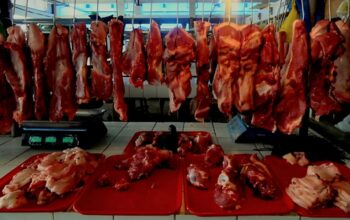
WHILE strongly opposed to the use of coal mineral to generate electricity, the province of Bohol is considering using diesel, which is also derived from fossil, apparently to fuel the planned island-based power plant in Imelda, Ubay town, as back-up source in times of calamities.
One Bohol Power spokesman and 1BP Technical Working Group member Engr. Algerico Siga was quoted that Energy Development Corporation (EDC) is to build a power plant in Imelda, Ubay town, to be fueled by diesel once the power supply agreement (PSA) is approved by the Energy Regulatory Commission (ERC).
“Matod pa ni Engr. Siga, kung ma-aprobahan na ang PSA, pwede na makasugod dayon ang EDC sa construction sa diesel power plant sa Imelda, Ubay.” (Engr. Siga said that if the PSA is okayed, EDC may come in to construct diesel power plant in said place), according to the facebook post of Gov Art. Yap.
It said that EDC was awarded on October 25, 2021 for aforesaid power project during the meeting of the so-called Bohol Energy Development Advisory Group (BEDAG) last week led by the governor. The target date for project completion would be on December 26, 2023.
The governor’s post continues that “the use of diesel power plant assured that it will not result to high power rates of electricity in the province once this (diesel power plant) operates”.
This is because what was offered (price of kilowatthour) during the bidding under contract is the charge for power used “regardless of what power source supply use by EDC.”
“Dugang gipasabot usab ni Engr. Siga nga ang option sa paggamit sa diesel power plant dili moresulta sa pagtaas sa power rate sama sa usual nga experience tungod kay kon unsa ang presyo per kilowatt per hour nga gi offer panahon sa bidding ug kung unsa ang gipirmahan sa kontrata, mao na ang presyo nga pagagamiton regardless kon unsa ang gamiton nga power source supply sa EDC. Nidugang si Engr. Siga sa pag ingon nga ang maong proyekto suma sa gikaigo-an sa gipirmahang kontrata, pagahumanon sa Dec. 26, 2023.”The governor said that those who attended the said meeting are: representatives of the DOE, Engr. Kelvin Ed D. Dajao; General Managers of the DUs, Engr. Dino Nicolas T. Roxas of BOHECO 1 & Chair of 1BP; Engr. Eugene Tan of BOHECO 2; Engr. Paulino Almedilla of Bohol Light Company Inc.; Forester Ariel N. Rica – PENRO Bohol; Atty. Lucas Nunag of Provl. Tourism Council; Engr Albert Uy of Bohol Chamber of Commerce & Industry; Mr. Aurelio Salgados, Jr of BANGON; Mr. Ribomapic D. Nacorda of Bohol Island State University; Atty John Titus Vistal of the Provincial Planning and Devt. Office; Atty. Abeleon Damalerio, representative of Cong. Edgar M. Chatto; and 1BP Technical Working Group members Engr. Danilo Quidlat, Engr. Algerico Siga, Engr. Joson Castro and Engr. Ariel Torrejos.
POWER NEED
The need for the island-based power plant is pushed following the suffering of the entire island-province had experienced when disasters struck the province. It endured months of without power after the earthquake on October 15, 2013 and the devastation caused by super typhoon Odette on December 16, 2021.
Bohol is largely dependent on the Bohol-Leyte Power Interconnection from the geothermal plant of Leyte province that could supply some 100 megawatts via undersea cable.
Bohol now needs some 80-90 MW to power its electricity requirement in peak hours, according to distribution utilities (DUs).
It has three hydro electric plants located in Loboct town (1.2MW), Sevilla town (2-3MW) and the Hanopol, Balilihan town (4-5MW). It also relies much on the standby diesel power barge (25MW) moored in Tapal port, Ubay town and the vintage Bohol Diesel Power Plant (BDPP) (16MW) in barangay Dampas, Tagbiaran City.
But, according to Siga in earlier interview days after the Odette, it may take three years for these hydro plants to operate after being adversely affected by Odette.
COSTLY DIESEL
After typhoon Odette’s devastation, the diesel power barge and the diesel plant in the city operated to provide the electricity need of the province while the temporary and permanent solid structures for Leyte-geothermal power link from island town of President Carlos P. Garcia were to be erected in Ubay town.
The power rates have gone up for the use of diesel as fuel of the power barge and the BDPP.
The DUs announced this (increase of power rates) prior to the operation of the two diesel powered plants.
NO TO COAL
It will be recalled that the Sangguniang Panlalawigan passed Provincial Ordinance No. 2018-005, “declaring the official stand of the provincial government of Bohol disallowing the building or establishment of any coal power plant in the province of Bohol.”
Section 1 states that the establishment of coal powered electric plant is “contrary to its avowed vision, mission and goals.”
Section 2 of the said Ordinance provides for the conduct of information and education campaign “to let the Boholano people clearly understand that should there be increase in the cost of power after the competitive selection process, this is not solely due to generation cost, but also due to the need to pay for a clean and safe environment.”
FOSSIL FUEL
According to the United States Energy Information Administration (USEIA), “Diesel fuel is the common term for the distillate fuel oil sold for use in motor vehicles that uses the compression ignition engine named for its inventor, German engineer Rudolf Diesel. He patented his original design in 1892. Diesel fuel is refined from crude oil and from biomass materials.”
It added that diesel contains “sulfur that produces air pollution emissions that are harmful to human health.”
Coal, on the other hand, is black sedimentary rock composed of carbon and hydrocarbon which contain energy than can be released by combustion, according to the National Geographic.
“Fossil fuels are formed from the remains of ancient organisms. Because coal takes millions of years to develop and there is a limited amount of it, it is a nonrenewable resource.” (rvo)



